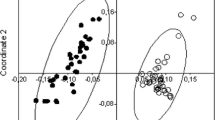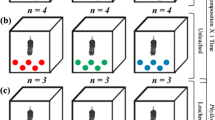Abstract
The niche of aquatic insect herbivores can be determined by the resource quality of leaf litter species. We compared the niche functional trait of aquatic insect herbivores between Magnolia ovata (riparian tree) and Saccharum officinarum (sugar cane) leaf litter processing. We hypothesized M. ovata and sugar cane leaf litter species would influence different functional traits niche of aquatic insect herbivores due to different quality resource leaves. We performed colonization experiments using dry leaves in five streams during 30–34 days. We utilized five replicates per leaf litter (n = 25) containing 12 g of dry leaves. We compared the niche specialization of herbivore functional traits using the Community Weight Mean (CWM) index and throughout herbivore abundance and the similarity composition of taxa. Additionally, we analysed the influence of organic matter in the CMW index of herbivore functional trait niche. We observed a higher abundance of shredders than scrapers in both leaf litter species. The M. ovata leaf litter selected a more specialized niche of respiration trait composed mainly chironomid shredder larvae, with the osmotic mechanism. The community structure differs weakly with a stronger and positive relationship between organic matter and respiration CWM index in riparian than sugar cane leaf litter. Concerning different composition communities between leaf plants, we consider that aquatic insect herbivore demonstrates a preference to leaf litter species with a specific resource. Additionally, most taxa adapt their feeding habit dependent on the availability of resource food.


Similar content being viewed by others
References
Bakker ES, Wood KA, Pagès JF, Veen GC, Christianen MJ, Santamaría L, Hilt S (2016) Herbivory on freshwater and marine macrophytes: A review and perspective. Aquat Bot 135:18–36
Benstead JP, Pringle CM (2004) Deforestation alters the resource base and biomass of endemic stream insects in eastern Madagascar. Freshw Biol 49:490–501
Berg K, Jónasson PM, Ockelmann KW (1962) The respiration of some animals from the profundal zone of a lake. Hydrobiologia 19:1–39
Boyero L, Barmuta LA, Ratnarajah L, Schimdt K, Pearson RG (2012) Effect of exotic vegetation on leaf break down by shredders: a tropical-temperate comparison. Fresh Sci 31:296–303
Brodersen KP, Pedersen O, Walker IR (2008) Respiration of midges (Diptera; Chironomidae) in British Columbian lakes: oxy-regulation, temperature and their role as palaeo-indicators. Freshw Biol 53:593–602
Castro DMP, Carvalho DR, Pompeu PS, Moreira MZ, Nardoto GB, Callisto M (2016) Land Uses Influences Niche Size and the Assimilation of Resources by Benthic Macroinvcertebrates in Tropical Headwater Streams. PLoS One. https://doi.org/10.1371/journal.pone.0150527
Choi C, Bareiss C, Walanciak O, Gross E (2002) Impacto f plophenols on growth of the aquatic herbivore Acentria ephemerella. J Chem Ecol 28:2245–2256
Claeson SM, LeRoy CJ, Barry JR, Keuhn KA (2014) Impacts of invasive riparian knotweed on litter decompostiorn, aquatic fungi and macroinvertebrates. Biol Invasions 16:1531–1544
Corbi JJ, Trivinho-Strixino S (2016) Chironomid species are sensitive to sugarcane cultivation. Hydrobiologia 785:91–99
Corbi JJ, Kleine P, Trivinho-Strixino S (2013) Are aquatic insect species sensitive to banana plant cultivation? Ecol Indic 25:156–161
Domínguez E, Fernadéz HR (2009) Macroinvertebrados bentónicos sudamericanos: sistemática y biología. Tucuman, Argentina.
Elliot JM (2008) The ecology of reffle beetles (Coleoptera: Elmidae). Freshw Rev 1:189–203
Going BM, Dudley TL (2008) Invasive riparian plant litter alters aquatic insect growth. Biol Invasions 10:1041–1051
Huntly N (1991) Herbivores and the dynamics of communities and ecosystems. Annu Rev Ecol Syst 22:477–503
König R, Hepp LU, Santos S (2014) Colonization of low and high-quality detritos by benthic macroinvertebrates during leaf breakdown in a subtropical stream. Limnologica 45:61–68
Laliberté E, Legendre P, Shipley B (2014) FD: Measuring functional diversity from multiple traits, and other tools for Funct. Ecol. R package version 1-12
Lecerf A, Risnoveanu G, Popescu C, Gessner MO, Chauvet R (2007) Decomposition of diverse litter mixtures in streams. Ecology 88:219–227
Leite-Rossi LA, Saito VS, Cunha-Santino MB, Trivinho-Strixino S (2016) How does leaf litter chemistry influence its decomposition and colonization by shredder Chironomidae (Diptera) larvae in a tropical stream? Hydrobiologia 771:119–130
Leite-Rossi LA, Saulino HHL, Shimakuro EM, Cunha-Santino M, Trivinho-Strixino S (2019) Shredder Chironomid Diets Are Influenced by Decomposition Rates of Different Leaf Litter Species. Neotrop Entomol 48:38–49
Linares MS, Callisto M, Marques JC (2018) Compliance of secondary production and eco-exergy as indicators of benthic macroinvertebrates assemblages' response to canopy cover conditions in Neotropical headwater streams. Sci Total Environ 613-614:1543–1550
R Development Core Team (2014) R: A Language and Environment for Statistical Computing. R Foundation for Statistical Computing, Vienna, Austria Available at: http://www.R-project.org (accessed 26.10.16)
Ricotta C, Moretti M (2011) CWM Rao’s quadratic diversity: a unified framework for functional ecology. Oecologia 167:181–188
Saulino HHL, Trivinho-Strixino S (2018) Native macrophyte leaves influence more specialisation of neotropical shredder chironomids than invasive macrophyte leaves. Hydrobiologia 813:189–198
Saulino HHL, Thompson RM, Trivinho-Strixino (2018) Herbivore functional traits and macroinvertebrates food webs have different responses to leaf chemical compounds of two macrophyte species in tropical lakes’s litoral zone. Aquat Ecol 52:165–176
Tonin AM, HEPP LU, Gonçalves JF Jr (2017) Spatial Variability of Plant Litter Decomposition In Streams Network: from litter bags to watersheds. Ecosystem. 21:567–581. https://doi.org/10.1007/s10021-017-0169-1
Trivinho-Strixino S (2014) Ordem Diptera. Família Chironomidae. Guia de identificacão de larvas. In: Hamada N, Nessimian JL, Querino RB (eds) Insetos Aquáticos na Amazônia brasileira: taxonomia, biologia e ecologia. Editora do INPA, Manaus, pp 457–660
Wetzel RG, Likens GE (1991) Limnological Analyses. Springer, New York
Wood AW, O’Hare MT, McDonald C, Searle KR, Daunt F, Stillman RA (2017) Herbivore regulation of plant abundance in aquatic ecosystems. Biol Rev 92:1128–1141
Young BA, Schimidt D, Sheldon F (2013) Small-scale pattern of genetic variation in a headwater specialist mayfly: No influence of selective forest harvesting on diversity. Austral Ecol 38:504–515
Acknowledgements
The authors would like to thank the São Paulo Research Foundation (FAPESP) for the financial support and the scholarship awarded to the first author (Process 2018/14709-5).
Author information
Authors and Affiliations
Contributions
GC Vieira and S. Trivinho-Strixino—planned the designed and executed the work. HHL Saulino—analysed the dates and wrote the manuscript.
Corresponding author
Additional information
Edited by Eugenio E de Oliveira – UFV
Publisher’s Note
Springer Nature remains neutral with regard to jurisdictional claims in published maps and institutional affiliations.
Rights and permissions
About this article
Cite this article
Saulino, H.H.L., Vieira, G.C. & Trivinho-Strixino, S. Aquatic Insect Herbivore Functional Community Traits Respond to a Different Niche Between a Riparian and Sugar Cane Leaf Litter Processing. Neotrop Entomol 49, 33–39 (2020). https://doi.org/10.1007/s13744-019-00726-0
Received:
Accepted:
Published:
Issue Date:
DOI: https://doi.org/10.1007/s13744-019-00726-0




